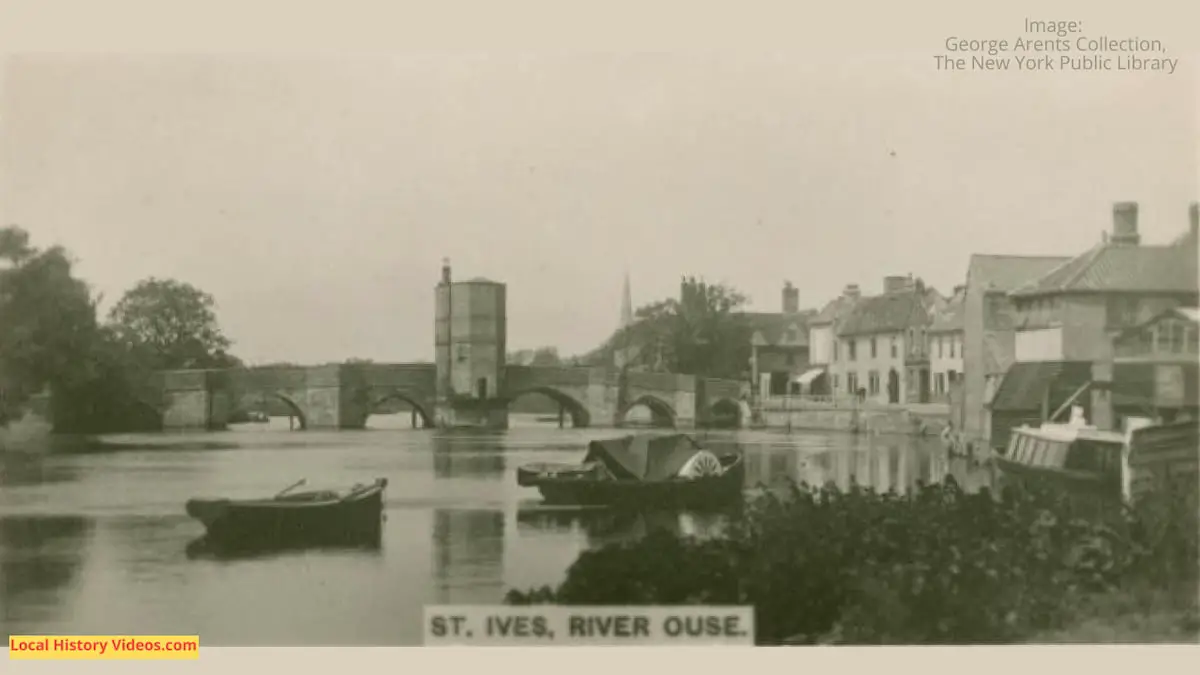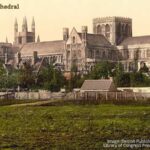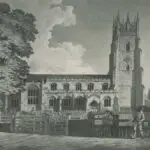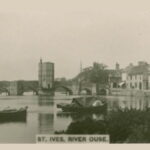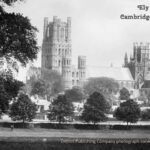Glimpse history through old images of St Ives, Cambridgeshire, England.
St Ives in 1937
A silent, black and white newsreel about a children’s angling contest includes a couple of nice shots of local streets and buildings.
Mass Attack (1937) – British Pathé on YouTube
St Ives in 1941
Recorded during World War II, this short newsreel shows the historic streets and buildings of this Huntingdonshire community, including the barn where Oliver Cromwell and his men had hidden from danger.
St Ives – Hunt Issue Title Is Seeing’s Believing (1941) – British Pathé on YouTube
A bit of St Ives history
Extract from: “Handbook for Hertfordshire, Bedfordshire, and Huntingdonshire …“, by John Murray (Firm)
Published in 1895
Pages 236 – 239
St. Ives (Joint Stat. G. E. and
Midland Rlys.), a small ancient
town situated on the river Ouse.
In Saxon times it was called Slepe,
and is so recorded in the Domesday
Survey. It afterwards obtained the
name of St. Ives from Ivo, a Persian Bishop who came to England as a
missionary and resided here.
He died about the year 600 A.D., and it
is supposed that he was buried
where the old priory stood. In the
reign of King Edgar, Ethelstan
Manvessune, a noble Saxon, be queathed various estates to the
Abbey of Ramsey, and amongst
them”certain land Slepe,”but it
was not to become the property of
the church till after the death”of
Alfwenne, his youngest daughter,”
and if she had an heir of him
also.”Some disputes, however,
arising as to this disposition of the
property, it was agreed on a com
promise, that the land of Slepe,
after the decease of Alfwenne,
should altogether remain to the
church of Ramsey whether she had
children or not. The monks of
Ramsey having obtained possession
of Ramsey, laboured to turn it to
the best advantage; and in 1001 A.D.
the remains of Ivo, which, it was
pretended, were accidentally dis
covered by a ploughman, were
conveyed with much solemnity to
Ramsey. On the spot where it was
stated that the remains had been
found Abbot Ednoth built a Ch.;
and afterwards, in 1017, a Priory
was erected by Earl Adelmar, who
placed here some Benedictine monks
from Ramsey, and granted them
various privileges. In 1207 the Ch.
and priory were burnt, but being
rebuilt they continued in subordination to Ramsey till the Dissolution, when they were granted by
Henry VIII. to Sir Thomas Audley.
The manor is known as”St. Ives
or Slepe and Burstellars.”As the
Saxon name of the town did not
disappear entirely till about 1600,
it is supposed that at first only the
place where the body of Ivo was
found was called St. Ives; and the
name of”Burstellars,”derived probably from the Danish bus( under
wood) and tellar (tiller of bush
land), indicated that there were
two manors.
The Ch. of All Saints is a light
and handsome Perp. edifice of stone,
consisting of a chancel, nave with
clerestory, aisles, and tower with
spire at the W. end. The E.
window of the chancel with five
lights has good tracery. The nave
is separated from the aisles by
clustered_piers and lofty pointed
arches. The E. window of the S
aisle is very early Dec., and on the
S. side of it is an E. E. donble
piscina. A handsome choir screen
and loft, surmounted by an organ,
has recently been erected. The
S. porch is very fine, and has a
good niche on either side of the
archway. The tower, supported
by staged buttresses, has a very
fine W. doorway with rich spandrils
and a niche on either side, the
doors themselves are excellent specimens of panel tracery, but are
much dilapidated. The spire,
twice blown down, in 1741 and 1822,
was rebuilt in 1880. In the tower
is a ring of 8 bells, all originally
( now 6 of them only) were founded
by Henry Penn, at Peterborough
in 1723. They were said to have.
been at first intended for God
manchester Ch. Anyhow, they
caused the death of their founder,
for the people of St. Ives, being
dissatisfied with the bells, entered
a law suit against Penn, which he
won after a protracted litigation;
but, mounting his horse in the
Inn yard to ride home to Peter
borough, he fell dead from excite
ment. Till a few years ago there
was in the ch.-yd. a tombstone to
a noted gambler with the following
epitaph
“Here lies the body of All Fours,
Who spent his money and pawned his
clothes;
If any one should ask his name
“Tis Highest, Lowest, Jack and Game.”
Dr. Robert Wilde( d. 1678) bequeathed fifty pounds, the yearly
interest to be expended in the pur
chase of six Bibles, which should be
“cast for by dice”on the Communion table every year by six
boys and six girls of the town. This
singular custom has been regularly
observed, but the practice of throw
ing dice on the Communion table
has been discontinued, and the
raffling now takes place on a table
placed in the chancel.
The old stone bridge over the
river Ouse is one of the most
interesting architectural features of
the town. It is believed to have
been built by the Abbots of Ramsey
in the early part of the 15th cent.
It has six arches, four of which are
pointed; the other two semicircular
were rebuilt by William Duke of
Manchester in 1716. Over the
centre pier is an old house, the
upper part of which was destroyed
by fire in 1689, and rebuilt of brick.
It is traditionally reported to have
served as a lighthouse for persons
navigating the river. It was anciently used as a chapel, but is now
a dwelling – house. The river here,
although sluggish, is picturesque,
and does not deserve the descrip
tion given of it by Thomas Carlyle,
who thus writes of it:”The Ouse
flows here, you cannot without
study tell in which direction, fringed
with grass, reedy herbage, and
bushes, and is of the blackness of
Acheron, streaked with foul metallic
glitterings and plays of colour.”
A great part of St. Ives was
destroyed by fire on the 13th April,
1689, when the houses belonging to
122 families were laid in ashes, the
whole loss being estimated upwards
of 13,0007.
Slepe Hall, which was demolished
in 1848, was noted for having been
the residence of Oliver Cromwell
during his residence at St. Ives,
when he devoted his time to farm
mg. The site is now occupied by
private houses, Cromwell Terrace
and Cromwell Place. There is not
much authentic information con
cerning Cromwell whilst at St. Ives,
but Carlyle, in his Letters and
Speeches of Oliver Cromwell,
quotes a letter written by him on
11th January, 1635, to his”very
loving friend Mr. Storie, at the sign of the Dog ‘ in the Royal Ex
change, London,”and Cromwell’s
name appears in parish register on
7th April, 1631.
Across the bridge a road to the
rt. leads to the village of Heming
ford Grey, 1 m., noted as the
birthplace of the beautiful Misses
Gunning. Maria, the elder sister,
married in 1752 the 6th Earl of
Coventry; and Elizabeth married
in the same year the 6th Duke of
Hamilton, and afterwards became
the wife of the 5th Duke of Argyll.
With regard to her marriage with
the Duke of Hamilton the follow
ing account is given by Horace
Walpole:”The Duke carried off
Miss Gunning from a ball, and not
withstanding the lateness of the
hour, sent for the rector of St.
George’s, Hanover Square, to marry
them. Dr. Trebeck, however, re
fused to perform the
without license and
Duke swore he would send for the
Archbishop. At last they were
ceremony
ring. The
married with a ring of a bed curtain
at half – an – hour past 12 at night at
May Fair Chapel.”This clandes
tine marriage was the immediate
cause of the Marriage Act.
The poet Cowper wrote”The
Dog and the Water Lily”whilst
on a visit here.
“The moon was shady, and soft airs
Swept Ouse’s silent tide;
When ‘ scaped from literary cares,
I wandered on his side.
It was the time when Ouse displayed
His lilies, newly blown:
Their beauties I, intent, surveyed,
And one I wished my own.”
The Ch. of St. James stands on the
S. bank of the Ouse. It is an ancient structure with some Norm. and
E. E. remains. It consists of a
chancel, clerestoried nave, aisles and
W. embattled tower with pinnacles.
There was formerly a spire, but it
was blown down in 1741, the base of
it only remains. The manor was
granted by King Hardecnut through the entrenties of his mother Emma
to the Ch. at Ramsey, but it was
seized by William the Conqueror.
The Manor House( Mrs. Heseltine),
the birthplace of the Misses Gun
ning, is of great antiquity, and has
some thick wall with Norm. door
ways still standing. The water – mill
is also an ancient structure.
More about Cambridgeshire
- Old Images of Cambridgeshire, England
- Old Images of Wisbech, Cambridgeshire
- Old Images of Soham, Cambridgeshire
- Old Images of St Ives, Cambridgeshire
- Old Images of March, Cambridgeshire
- Old Images of Huntingdon, Cambridgeshire
- Old Images of Peterborough, Cambridgeshire
- Old Images of Cambridge, Cambridgeshire
- St Neots: Old Photos And Films
- Chatteris History in Old Photos and Film
- Cambridgeshire: Local History Resources
- Old Images of Ely, Cambridgeshire

